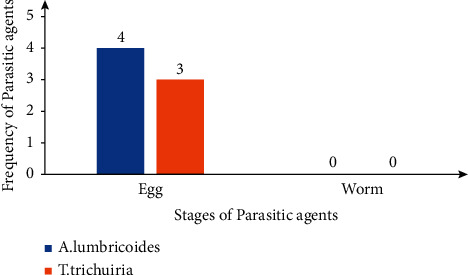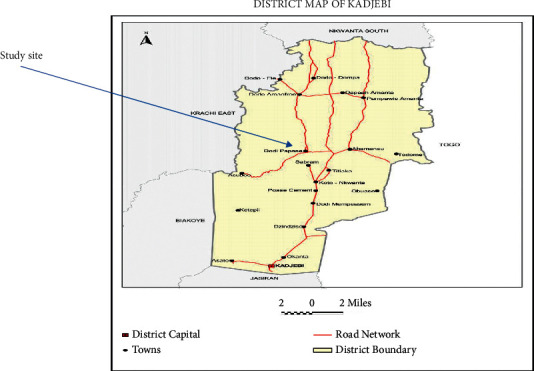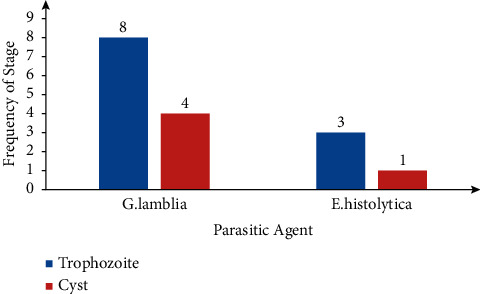Intestinal Parasitic Infection and Associated Risk Factors among HIV-Infected Patients Seeking Healthcare in a Rural Hospital in Ghana.
IF 1.1
Q4 MICROBIOLOGY
引用次数: 0
Abstract
Background Parasitic infections among human immunodeficiency virus (HIV)-infected patients are common in various regions and populations across the world and have since remained a persistent public health challenge. Sub-Saharan Africa harbors the greatest burden of the infections due to sociodemographic and behavioral factors. However, the prevalence of gastrointestinal parasitic infections among HIV-infected persons has been poorly investigated in Ghana. Aim This study sought to determine the prevalence of gastrointestinal parasitic infections and associated factors in HIV-infected individuals attending the antiretroviral therapy (ART) clinic in St. Mary Theresa Hospital, Dodi Papase. Methods A cross-sectional study was conducted from June 2021 to September 2021 among three hundred and thirty-five HIV-infected individuals in the study area. Sociodemographic and behavioral factors were collected with the aid of a close-ended structured questionnaire. Furthermore, stool samples were collected from each participant and examined for the presence of intestinal parasites by microscopy using direct wet mount, formol-ether concentration, and modified Ziehl–Neelsen (Zn) techniques. Data obtained were analyzed using Statistical Package for Social Sciences (SPSS) version 22.0 and Graphpad Prism version 8. Results The prevalence of gastrointestinal parasitic infections was 5.97%. Species-specific prevalence was found to be 2.99% for Giardia lamblia, 1.19% for Ascaris lumbricoides, and 0.90% each for Entamoeba histolytica/dispar and Trichuris trichiura. There was a significant association between participants' educational level and intestinal parasitic infection. In addition, gastrointestinal parasitic infections were not found to be associated with age. Unemployed participants, those with a lower frequency of deworming, and those who do not use water closet toilet facilities were at a higher risk of getting infected. Conclusion The lower infection rate recorded in this study suggests that public health interventions put in place are yielding significant results. Even though the prevalence is low, routine screening of all HIV-infected patients for parasitic infection is recommended to ensure timely, effective treatment and comprehensive care.



加纳农村医院寻求医疗保健的艾滋病毒感染者肠道寄生虫感染及其相关风险因素
背景:人类免疫缺陷病毒(HIV)感染患者的寄生虫感染在世界各地的不同地区和人群中很常见,并且一直是一个持续的公共卫生挑战。由于社会人口和行为因素,撒哈拉以南非洲的感染负担最重。然而,在加纳,对艾滋病毒感染者中胃肠道寄生虫感染的流行情况调查甚少。目的:本研究旨在确定在Dodi Papase圣玛丽特蕾莎医院抗逆转录病毒治疗(ART)诊所就诊的hiv感染者胃肠道寄生虫感染的患病率及其相关因素。方法:于2021年6月至2021年9月对研究地区的335名hiv感染者进行了横断面研究。通过封闭式结构化问卷收集社会人口和行为因素。此外,收集每位参与者的粪便样本,并使用直接湿载、甲醛醚浓度和改进的Ziehl-Neelsen (Zn)技术通过显微镜检查肠道寄生虫的存在。使用SPSS 22.0版和Graphpad Prism 8版对所得数据进行分析。结果:胃肠道寄生虫感染率为5.97%。蓝氏贾第虫、类蛔虫、溶组织内阿米巴和毛滴虫的种特异性感染率分别为2.99%、1.19%和0.90%。受教育程度与肠道寄生虫感染有显著相关。此外,胃肠道寄生虫感染未发现与年龄相关。失业的参与者、驱虫频率较低的参与者以及不使用抽水马桶设施的参与者感染的风险更高。结论:本研究记录的较低感染率表明,公共卫生干预措施正在产生显著效果。尽管流行率很低,但建议对所有感染艾滋病毒的患者进行寄生虫感染的常规筛查,以确保及时、有效的治疗和全面的护理。
本文章由计算机程序翻译,如有差异,请以英文原文为准。
求助全文
约1分钟内获得全文
求助全文

 求助内容:
求助内容: 应助结果提醒方式:
应助结果提醒方式:


